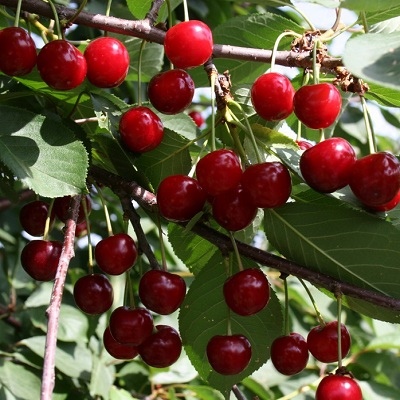
- Authors: A.I. Astakhov, M.V. Kanshina (All-Russian Research Institute of Lupine)
- Year of approval: 1986
- Barrel type: wood
- Crown: round, compact, dense
- Escapes: medium, thin, straight, no pubescence
- Leaves: small, narrow, elliptical, elongated-pointed, light green, matte, boat-concave
- Flowers: medium, white, goblet
- Flowering and fruiting type: on short fruit branches
- Fruit size: average
- Fruit shape: rounded flat
Cherry is a frequent visitor to the garden plot of every summer resident. The main thing is to choose a productive and non-capricious species that will delight with abundant harvests. These include the domestic variety Oktava with medium ripening periods.
Breeding history
The cherry tree Octave appeared in 1982 thanks to the work of a group of agricultural scientists of the All-Russian Research Institute of Lupine (Astakhov A.I. and Kanshina M.V.). The fruit crop has been undergoing variety trials for 4 years and in 1986 it was entered into the State Register of Breeding Achievements of Russia. Cherry is zoned in the Central region. Cherry feels comfortable in intensive plantings.
Description of the variety
The tree is short and very compact. In favorable climatic conditions, the Oktava cherry grows up to 150-200 cm in height. The tree is characterized by a rounded crown shape, high thickening with small light green leaves, upright shoots without edges, and a strong root system. In each inflorescence, 5-6 large white flowers are formed. Cherries form on shortened fruit twigs.
Fruit characteristics
Cherry Oktava is characterized as a medium-fruited species. Berries grow up weighing 3.9 grams, of a classic flat-round shape, with a shiny dense peel without rigidity. Ripe cherry has a uniform deep cherry color, close to black. The stalk is separated from the berries dryly.
Cherries have a universal purpose - they are eaten fresh, used in cooking, boiled compotes, processed into jam, frozen, and also harmoniously combined with other berries and fruits. The harvested crop perfectly tolerates long-distance transportation.
Taste qualities
The berries have a rich and deep taste. The dark cherry flesh is firm, fleshy, tender and very juicy. The taste is pleasant, rich-sweet with pleasant sourness and subtle astringency. Inside the berry there is a small bone, which is easily separated from the pulp. Cherry juice is dark in color. The pulp contains more than 15% sugars and 1% acids.
Ripening and fruiting
Octave is a mid-late cherry appearance. The tree begins to bear fruit in the 3-4th year after planting. Mass ripening of cherries occurs in mid-July. If you plant cherries in the southern region, then you can taste the harvest a few weeks earlier.

Yield
The productivity of the variety is high and stable. Providing the cherries with proper care, as well as under favorable weather conditions, up to 100 centners of fruits can be harvested from 1 hectare of cherry plantations. On average, one small tree gives up to 40 kg of cherries.
Self-fertility and the need for pollinators
Cherry Oktava is self-fertile, but cross-pollination is recommended to obtain the highest yield possible. To do this, donor trees with similar flowering times need to be planted nearby. Suitable pollinating varieties are: Lyubskaya, Shokoladnitsa and Griot Moskovsky.
Landing
The best time for planting a cherry seedling is spring: late March - early April. The recommended planting pattern is 4x3 meters.


Growing and care
You need to plant a cherry tree in the southern part of the garden, where sun and warmth are abundant. It is important that the plantings are protected from drafts and gusty winds. The variety can be propagated by numerous methods - seeds, rootstocks and vegetative methods.
Agrotechnics near the tree are simple: regular drip irrigation (after flowering, during the pouring of fruits, before winter), loosening the soil, applying fertilizers from the third year of growth (spring, summer and autumn feeding), forming the crown (non-tiered type), sanitary and rejuvenating pruning of branches, mulching, as well as prevention of diseases and pest attacks. In regions with harsh winters, tree protection with the use of roofing material, spruce or reeds will be required. The tree is protected from rodents, which rarely attack, using standard methods - the damaged areas are treated with garden varnish.


Disease and pest resistance
The immunity of the variety is assessed as medium. This is what provides good resistance to diseases such as coccomycosis and moniliosis.
Requirements for soil and climatic conditions
The tree is not very demanding on the quality of the soil. It is enough for the soil to be fluffy, air and moisture permeable, fertile and with a neutral level of acidity. Lime will help level out the acidity. The passage of groundwater must be deep, since stagnant moisture will negatively affect the root system of the culture.
































































